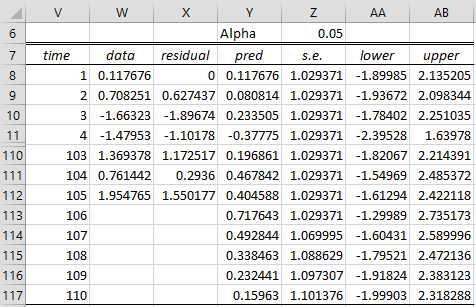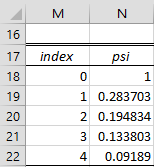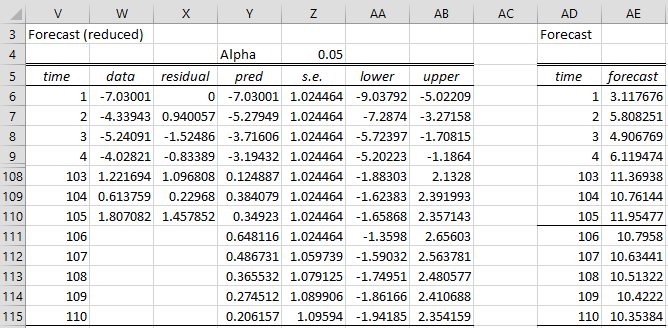We now show how to create forecasts for a time series modelled by an ARMA(p,q) process.
Forecast Example
Example 1: Create a forecast for times 106 through 110 based on the ARMA(1,1) model created in Example 1 of Calculating ARMA Coefficients using Solver.
The result is shown in Figure 1, where we have omitted the data for times 5 through 102 to save space.
Figure 1 – Forecast for AR(1,1) process
Columns V, W and X are just copies of columns E, F and G from Figure 1 of Calculating ARMA Coefficients using Solver. The predicted values in Y for the observed data in the time series (range Y8:Y112) is simply the data element minus the residual; e.g. cell Y8 contains the formula =W8-X8.
The predicted (or forecasted) value at time 106 (cell Y113) is based on the equation that defines the ARIMA(1,1) process, namely
Thus, the forecast value at time i = 106 is
![]()
![]()
Note that since we don’t have an observed value for ε106, we use the theoretical mean value, namely zero. The forecasted value at time i = 106 is calculated in Figure 1 using the formula =SUMPRODUCT(W112,J$8)+SUMPRODUCT(X112,K$8). For this model, this formula can be simplified to =W112*J8+X112*K8, but the longer formula will come in handy when we create forecasts using ARMA(p, q) where p and/or q is larger than 1.
The forecast at time i = 107 is calculated by
![]()
This time, there are no observed values for ε106, ε107, or y106. As before, we estimate ε106 and ε107 by zero, but we estimate y106 by the forecasted value ŷ106. This is accomplished in Excel using the formula =SUMPRODUCT(Y113,J8).
The forecasted values at times 108, 109 and 110 are calculated in a similar manner.
Standard Errors
We next look at the standard error for the forecast values. For the observed times, the standard error is σ, which can be estimated by =
=
= 1.029371, where SSE = 110.19884 (see Figure 2 of Calculating ARMA Coefficients using Solver).
The standard error of the mth forecasted value (after the n observed values) is given by the formula
is the MA(∞) representation of the ARMA process. As before, we estimate σ by estimated by = 1.029371.
The psi coefficients for the MA(∞) representation are as shown in Figure 2.
Figure 2 – Psi coefficients for MA(∞) representation
Here the formula =PSICoeff(J8,K8) is inserted in range N18:N22.
Thus, for example, the standard error for ŷ108 is
This value is calculated (cell Z115) by the formula =K$18*SQRT(SUMSQ(N$18:N20)).
The 95% confidence interval for ŷ108 is therefore
which is (-1.79521, 2.472136), as shown on row 115 of Figure 1. For example, the formula in cell AB115 is =Y115+NORM.S.INV(1-Z$6/2)*Z115.
Example with Constant
Example 2: Create a forecast for times 106 through 110 based on the ARMA(1,1) model created in Example 2 of Calculating ARMA Coefficients using Solver.
The process is identical to that shown in Example 1. The only difference is that this time there is a constant term in the ARMA(1,1) model. The result is shown in Figure 3.
Figure 3 – Forecast for ARMA(1,1) process with non-zero mean
As we discuss in Evaluating the ARMA Model, the left side of Figure 3 contains the forecast not for the original yi data, but for the zi data where zi = yi – µ and the estimate for µ is 10.147687 (cell K7 in Figure 4 of Calculating ARMA Coefficients using Solver). To create a forecast for the yi time series, we need to add 10.147687 to the forecasted zi values. This is done in column AE.
E.g., cell AE115 contains the formula =Y115+K7, while cell AE6 contains the formula =W6+K7.
Examples Workbook
Click here to download the Excel workbook with the examples described on this webpage.
References
Triacca, U. (2014) Forecasting stationary time series
https:// No longer available online
Hamilton, J. D. (1994) Time series analysis. Princeton University Press
https://press.princeton.edu/books/hardcover/9780691042893/time-series-analysis
Hitchcock, D. (2016) Forecasting
https://people.stat.sc.edu/hitchcock/stat520ch9slides.pdf




